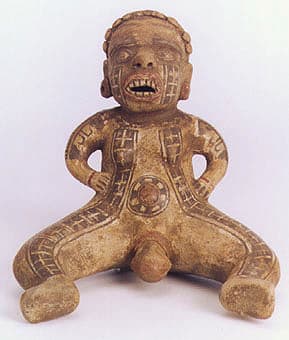Terracotta Statue of a Woman Giving Birth, 500 CE - 800 CE
Terracotta
8
PF.4496
One of the most common functions of living things is the act of giving birth. And yet it is still a mystery. With all modern science to help us, the...
One of the most common functions of living things is the act of giving birth. And yet it is still a mystery. With all modern science to help us, the act of producing a child is wondrous and painful, miraculous and heart rending. Different cultures have devised various ways of dealing with the outward expression of this most beautiful act; either by hiding it behind a wall of fear and prudery, (like sex itself); or of openly celebrating it as the greatest moment in a person's life. In the latter category we can place this unique sculpture. Here we see a woman in the final stages of giving birth. Her baby's head has just appeared and her agony is nearly over. With dramatic and graphic effect the artist has brought us straight into the delivery room, and in fact even closer, as if we are directly participating in the joy and pain of this woman. She appears to be a member of an elite class indicated by the elaborate scarification or body paint, the ear spools and appliquéd hair band. The places where red paint is applied may be significant, particularly on the enlarged navel. Our eyes are immediately drawn into it as if into a vortex, swirling into the womb where the life force originates. It is possible this statue was a ritual object intended to aid in childbirth by actively drawing pain from the woman into itself. Perhaps placed next to the mother while she is delivering. Whatever her function, she is a bold and poignant figure for all women who have experienced that inexpressible miracle of giving life. HT.20.3cm(8IN):L.25.4cm(10IN)
